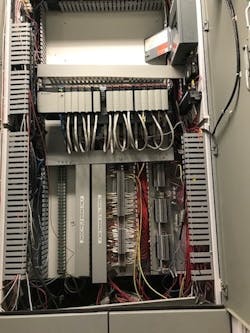Wastewater to Safe Water
About the author:
Kelvin Hurdle is North America water/wastewater industry manager for Rockwell Automation. Hurdle can be reached at [email protected].
The central California city of Monterey is located along the state’s coastline and features expansive views of the Monterey Bay. The area’s moderate climate makes it suitable for agriculture, earning it the nickname “Salad Bowl of the Nation,” with major farming productions providing a wide range of fruits, vegetables and even grapes for wine production.
The Monterey Regional Water Pollution Control Agency (MRWPCA) processes more than 18.5 million gal of wastewater per day for the region’s nine cities.
After completing an extensive research project in 1998, the agency determined that recycled water was safe for use on various crops. It decided to implement wastewater recycling programs to help support local crop irrigation needs. The agency provides recycled water for 12,000 acres of high-value food crops.
The programs would recycle wastewater pulled in from more than 10 different collection points for fresh, edible food crops, including artichokes, celery, broccoli, lettuce and cauliflower. The system includes the Salinas Valley Reclamation Project (SVRP) water recycling plant and the Castroville Seawater Intrusion Project (CSIP) distribution system. The gathered wastewater is cleaned through a process control system, which requires tight control over water quality analysis, level control, chemical additions and distribution.
Moving Forward
After approximately 15 years in operation, the control system running the process was nearing obsolescence. The dated Windows XP-based human machine interface (HMI) software had no backup power in case of a shutdown or emergency. Communications from the various disparate collection points were often delayed and irregular, leading to falsified communication statuses. Production data was logged manually, a time-sensitive and error-prone process that made data transfer unreliable. The system operators were unable to quickly gather data and trend reports critical for good decision-making. If an engineer put in a request for flow estimates, the data may not be available for weeks.
After a review of the SCADA and IT systems’ master plan with Kennedy Jenks Consultants, the agency decided it was time to upgrade its control and information system to assist in providing better operational control of irrigation demands, improve reliability and reduce risk.
The agency wanted a thorough understanding of the current SCADA system’s operational performance and turned to Rockwell Automation for a Installed Base Evaluation assessment. The process provided MRWPCA with a baseline understanding of its critical assets and obsolescence risks. The agency decided to rebuild the network and control infrastructure, and implement a PlantPAx distributed control system (DCS) from Rockwell Automation.
MRWPCA needed to lay new fiber optic runs to help support the newly virtualized system. The old programmable logic controller (PLC) code was quickly converted to the new PlantPAx system, helping to ease setup and programming during commissioning. The virtualized system would allow staff to start operations with a backup server in case the primary server failed, reducing the risk of interrupting recycled water deliveries.
The system was built using network communications standards based on EtherNet/IP to help streamline control and information flow, and enable real-time diagnostics and electronic documentation for the water treatment process.
Conversion to nine Ethernet I/O modules reduced installed I/O by an entire rack and increased the speed of the system. This enabled MRWPCA to physically move the PLC off the plant floor and into an administrative building.
A Rockwell Automation field service engineer came on site to help install the software and provide hands-on training for the agency staff.
Improving the information-enabled functionalities of the new DCS included redundant historian capabilities to provide real-time and historical water trends, such as system demands, levels and storage. The system collects, tracks and records key process data from approximately 2,300 historian tags to pinpoint water trends.
The new HMI was converted directly from the old software and implemented on redundant virtual servers, which has increased reliability and speed—all with improved screen aesthetics.
MRWPCA also implemented a FactoryTalk VantagePoint enterprise manufacturing intelligence (EMI) system from Rockwell Automation, which aggregates water treatment information from the historian and other assets. Operators can use the new EMI system to access various instrument and report tags in real time, as well as generate specific reports for process management and regulatory purposes.
Invaluable Information
The new information-enabled DCS has helped MRWPCA collect and access data that is crucial to the water treatment process. Operators can now access data from any of the disparate locations in real time.
The improved visibility and access to data has helped improve control over chemical usage. Because the treatment processes use upward of 5,000 lb of chlorine each day, achieving tighter control meant major cost savings. MRWPCA has been able to save $25,000 per year in chemical costs. The savings were not initially anticipated, but were an added benefit that provided a full return on investment on the HMI upgrade in just five years.
An energy audit yielded no further energy-saving suggestions—drives were running more efficiently and the system was fully optimized for energy savings. This was a win for the agency, as energy consumption often is one of the highest operating costs associated with water treatment.
MRWPCA was operating a booster station affected with a pressure problem, leading to multiple burst pipes, breaking valves and several other unresolved issues. Prior to the new DCS system, the county was unable to determine the root cause of the issue, but the data collection and trending capabilities helped enable operators to pinpoint and resolve the issue. The DCS system prevented the county from having to modify the booster system by putting in variable frequency drives, saving almost $3 million.
The agency also partnered with OSIsoft to use its open data infrastructure PI System to build dashboards of publicly facing data. The data is migrated from the SCADA system up to the enterprise system, and is then pushed up to Microsoft’s Azure cloud, where dashboards are available for constituents to see water quality in real time.
Advanced reporting capabilities within the new DCS also allowed for easy regulatory reporting. The process, which used to take up to three days, is now done through the click of a button.
MRWPCA is taking lessons learned from SVRP and CSIP projects and applying them to a new initiative: groundwater replenishment. The Pure Water Monterey project will leverage a PlantPAx system and aim to provide safe, reliable and sustainable drinking water.


